Back-Beaune Country Reds: Underappreciated Burgundy Regions With Energetic New Generation & Longtime Producers Leading a Quality Revolution. (7-Bottle Pack $378)
We have a bone to pick with anyone who badmouths backcountry Beaune red wine, and we make no bones about providing our supporting evidence.
The lesser known appellations in Beaune are producing increasingly discoverable Pinot Noirs whose prices remains in the range of the rational. Soil structure does not change, but overall terroir does: The climate is warming, and combined with the human touch—growing ever more experienced and technically savvy—marvelous red wines are being produced in places once considered marginal for Pinot Noir.
This package represents some of the best Beaune backcountry reds that we’ve encountered—they are wines from producers that consistently exceed expectations.
Build Beaune Backcountry Better
“Climate change is a fact,” says Laurent Audeguin, agronomist and enologist at the French Vine and Wine Institute. “As temperatures rise, the best vineyard sites become too warm. Vines are subject to increased risks of spring frost, sunburn and drought. The resulting wines, once defined by their elegance, subtlety and gracefulness, are getting riper by the year.”
As chilling as that prospect sounds, it appears unavoidable, and the silver lining in Burgundy is that once-borderline areas have begun to come into their own, while many of the old reliable names are planting new Pinot clones that accumulate less sugar and ripen later. And there are plenty to choose from: Although there are 47 officially allowed Pinot Noir clones, in reality, only a few are widely used. Leading Burgundy grower Louis Latour is also experimenting with massal selection and replanting with cuttings from existing vines as opposed to young, new nursery material in order to identify those clones best suited for the current environment.
Latour may be a household name, a newer generation of lesser Beaune winemakers are also actively looking for a silver lining in the cloud of global warming. A nationwide program launched in 2018 by the INAO allows wine regions to explore varieties (both white and red) that can cope with the changing climate, and in Beaune, neglected grapes like Aubin, Roublot, Sacy, Melon, César and Tressot are being considered, and many of them are already planted in small pockets throughout the region. Says Latour’s Christophe Deola, “Many of these old varieties were abandoned not from quality, but because they had too much difficulty ripening under past conditions.”
For a wine visionary, the time—as well as the grapes—may be ripe.
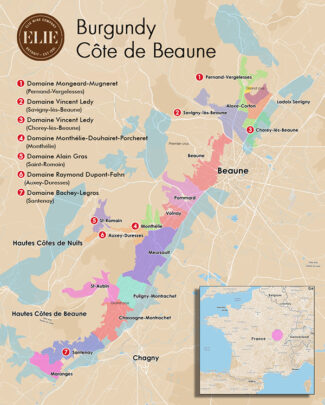
The offered 7-bottle package is comprised of one of each of the following wines at $378.
Pernand-Vergelesses – A Mingling of Earth and Red Berries
Vergelesses is a respected lieu-dit just south of Pernand, and in the tradition of the Côte d’Or, the village of Pernand usurped name of its most famous vineyard and tacked it onto its own. The vines, many at ideal elevations, lie adjacent to the red wine Grand Cru of Corton, but Pernand is located on the western side of the Corton hill where the terroir in general is better suited to Chardonnay. Still, the hillside contains microclimates where Pinot Noir thrives.
On the lower slopes, clay soils mixed with flinty residues are rich in potassium and phosphoric acid, while mid-slope, the pebbly limestone soils is ideal for Pinot Noir. The historical issue has been ripening this finicky grape and reds from the appellation have often seemed green compared with those of nearby Pommard and Volnay.
This is an area primed for a few degrees of warming, and recent hot summers have allowed some previously forgettable Pinot Noirs to lose the green edge. In fact, Pernand-Vergelesses underwent vineyard classification in 2001, much more recently than neighboring communes, and just under half the sites were rated Premier Cru, which were then subdivided into eight climats.
Domaine Mongeard-Mugneret
The name ‘Mongeard’ first makes an appearance in Burgundy in 1786, where records show a Mongeard working as vigneron for Domaine de la Romanée-Conti. Skip forward to 1945, when at the age of 16, Jean Mongeard (whose mother was from Famille Mugneret) made wine which he sold by the barrel to négociants. The entire 1945 crop was purchased by Baron le Roy, Marquis D’Angerville, and Henri Gouges, who suggested that the young Mongeard start bottling the wines himself.
In 1975, Jean’s son Vincent began working alongside his father and became responsible for viticulture and vinification of the domaine’s wines. He persuaded his father to return to the traditional method of filtering only in certain vintages. Upon his retirement in 1995, Vincent assumed complete leadership of the domain, which now covers more than 75 acres split among 35 appellations.
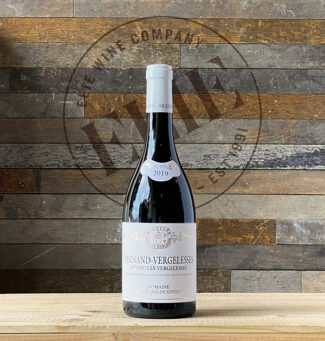 Domaine Mongeard-Mugneret, 2019 Pernand-Vergelesses Premier Cru Les Vergelesses ($85)
Domaine Mongeard-Mugneret, 2019 Pernand-Vergelesses Premier Cru Les Vergelesses ($85)
The name ‘Les Vergelesses’ refers to the lieu-dit’s long shapes, stemming the word ‘verge’, or rod. It’s an old agrarian measure equaling a quarter acre. With vines averaging 50 years old, Mongeard draws from just under two acres of the parcel, destemming the bunches, presses and ferments, then matures the wine in 30% new oak. As befits the source, it is fatter and more concentrated than Mongeard-Mugneret’s Village-level wine, and the purple-blue tint expresses raspberries, cherry cola, violets and blackcurrant leading to fleshy and nicely acidic finish.
Savigny-lès-Beaune – Beaune- and Vosne-Romanée-like Duality, With an Earthy Goût-de-Terroir
Chances are, you love wines from the Rhine and are passionate about wines from the Rhône, but at first glance, ‘wines of the Rhoin’ may look like a typo. In fact, this small river flows from the cliffs of Bouilland through the commune of Savigny-lès-Beaune, and alluvia from the overflow adds fertility to the lower slopes of the hills of Beaune. With nearly nine hundred acres of vineyard, the appellation is one of Burgundy’s largest.
Savigny’s terroir features a gentle gradient that becomes steeper as the altitudes approach 1300 feet, where the geology is similar to that of the great Grand Cru hill of Corton. Favored exposures face the south, where the soils are gravelly and scattered with oolitic ironstone. Near the river valley, the red-brown limestone becomes more clayey and pebbly, while the east-facing slopes consist of sand and limestone.
As rich in history as it is in Premier Cru vineyards (there are 22), Savigny-lès-Beaune was once a social hub where the nobility and clergy rubbed shoulders, and the near mythical regard for the quality of its wine is reflected in a stone carving on a Savigny château: “The wines of Savigny are nourishing, theological and keep death at bay.”
Domaine Vincent Ledy
Eight years of wine school may make you think of a professional student, but Vincent Ledy took all that accumulated scholastics and applied it to one of the smallest domains in Nuits-Saint-Georges. Scarcely five acres in total, he produces six labels for a total of 8,500 bottles.
“My first vintage was 2007”, he says. “All I had was a red Hautes-Côtes de Nuits. In 2008, I increased the size of the domain a little bit when I found a very small plot for Bourgogne rouge, less than a quarter acre just opposite of Clos de Vougeot on the other side of the Beaune-Dijon road. The soil is deep clay that is reflected in the character of the wine; blackcurrant is the dominating flavor, the same every vintage. Compared with the Bourgogne Hautes-Côtes de Nuits it is very different. The Hautes-Côtes is more about cherry flavors. The maximum yield for the regional appellations is 58 hl/ha, but the yield for my Bourgogne rouge is 50 hl/ha.”
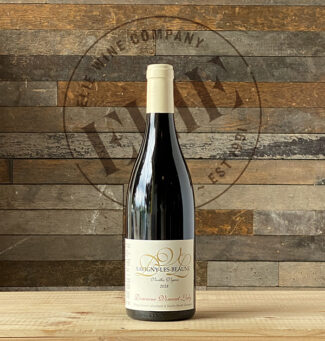 Domaine Vincent Ledy ‘Vieilles Vignes’, 2018 Savigny-lès-Beaune ($53)
Domaine Vincent Ledy ‘Vieilles Vignes’, 2018 Savigny-lès-Beaune ($53)
From the Villages-level lieux-dits Connardises and Aux Liards, the wine shows vivid ruby colors with garnet red tints. Violet, sweet pepper and hints of toast on the nose, followed by a silken palate and red fruit notes including cloudberry and ripe cherry.
Chorey-lès-Beaune – Pleasant, Once Were Labeled Aloxe-Corton
Chorey-lès-Beaune has an interesting dilemma: Rich neighbors. Immediately to the east, the appellation abuts Aloxe-Corton, and for many years, Chorey wines were labeled under the more prestigious Aloxe name, but in 1970, they were granted their own appellation when it was determined that Chorey’s terroir—limestone-marl alluvium over stony subsoil—warrants its own slice of recognition. Almost exclusively planted to Pinot Noir, the vineyards of Chorey have deeper beds of calcium-rich gravel near Aloxe, while toward Savigny are beds of clay with pebbly limestone.
Otherwise, Chorey is effectively a suburb of Beaune, without much picturesque glamour to attract attention from the press. It is pancake flat and without Premier Cru sites; Nathalie Tollot Chorey-based Domaine Tollot-Beaut says, “Our colleagues from other villages often joke ‘Oh, you are on the plain’s side of the highway.”
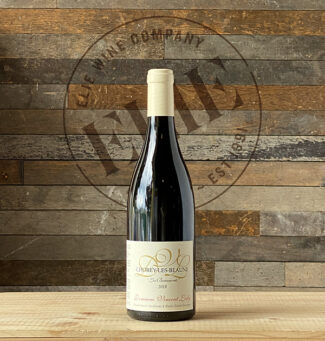 Domaine Vincent Ledy, 2018 Chorey-lès-Beaune ‘Les Beaumonts’ ($49)
Domaine Vincent Ledy, 2018 Chorey-lès-Beaune ‘Les Beaumonts’ ($49)
‘Les Beaumont’ is considered one of the best climats within Chorey-lès-Beaune, located in the westernmost section near Savigny. The wine shows floral-tinged flavors of cherries, slightly stewed plum braced by cloves and sweet spice.
Monthélie – Full, Rich Volnay-like
Author Pierre Poupon describes Monthélie as being, “…prettily nestled into the curve of the hillside like the head of Saint John against the shoulder of Jesus. Monthélie resembles a village in Tuscany.”
The appellation is home to 15 Premier Cru climat concentrated in one area to the east of the village, bordering the more prestigious vineyards of Volnay. A rose is a rose, but not all Premier Cru sites are created equal, and traditionally, those of Monthélie are not considered among Burgundy’s finest. Classic Monthélie wines are similar to those of neighboring Volnay (the villages are only a mile apart) but are not quite as full flavored or elegant, but they are generally considered to be superior to the red wines of Auxey-Duresses, also just a mile away in the other direction. Again, these are ideal terroirs to stir in a little extra warmth and innovation and follow the improvements with a corkscrew and glass.
Domaine Monthélie-Douhairet-Porcheret
The triumvirate of names each has its own special significance to the estate. Named first for the 300-year-old Southern Burgundy village in which it is located, Monthelie Douhairet was run by the Douhairet family for many years. In the early 1970s, the two sisters Armande and Charlotte Douhairet inherited the vines and decided to separate; Armande fought to keep her share while Charlotte sold hers. Then, in 1989, Madame Douhairet asked renowned winemaker André Porcheret to take charge and subsequently, added his name to the domain.
André Porcheret has been one of the great figures in Beaune; prior to overseeing Domaine Monthélie-Douhairet he was the cellar manager at the Hospices de Beaune, then worked for Lalou Bize Leroy to make wines at the newly created Domaine Leroy—whereupon, he returned to the Hospices de Beaune for another five year stint. Today, with his granddaughter Cataldina Lippo, he produces wines on M-D-P’s fifteen acres that are classic, elegant and true to the terroirs of Pommard, Volnay, Meursault and Monthélie.
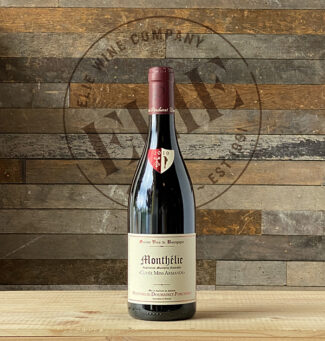 Domaine Monthélie-Douhairet-Porcheret ‘Cuvée Miss Armande’, 2019 Monthélie ($43)
Domaine Monthélie-Douhairet-Porcheret ‘Cuvée Miss Armande’, 2019 Monthélie ($43)
Armande Douhairet, known universally as ‘Miss Armande’ passed away in 2004, and to her memory, this cuvée is dedicated. The elevation of the vineyards is obvious in the brightness of the red fruit, evoking pie cherries, orange rind and raw cocoa. The texture is satiny and succulent, with a core of richness framed by lively acids and powdery tannins.
Saint-Romain – Glimpses of The Suaveness of Volnay and The Punch of Corton
Saint-Romain is a village of 200 inhabitants nestling within a valley behind Auxey-Duresses and surrounded by steep cliffs. Neither the population nor the wine trade ever really recovered from the phylloxera blight of the 19th century, and today, only about 7% of the land is under vine. Like Chorey-lès-Beaune, Saint-Romain has no Grand or Premier Cru sites.
The village is divided in two parts, Saint-Romain-le-Haut and Saint-Romain-le-Bas, one on top of the cliffs and one below, with the bulk of the vineyards in the lower section. It is, nonetheless, a geologist’s Valhalla. Saint-Romain sits on the lias (the earliest period of the Jurassic) and the blend of limestones and marls includes patches of clay. The vines face south/southeast and north/northeast at altitudes varying from 900 to nearly 1300 feet.
Domaine Alain Gras
Established in 1979, Alain Gras refers to his domain as ‘young’, and considering that Saint-Romain has been occupied for 6000 years, there may be truth to that. His vines spread over 30 acres in Saint-Romain, Meursault, and Auxey-Duresses.
Gras has found himself as a true ambassador of the Saint-Romain appellation. From a lineage of Burgundy vignerons that dates back five generations, he settled in Saint-Romain with his wife Nathalie and from the outset, their firm mission was to promote the appellation’s value. Joined by his son Arthur, Gras has advanced that value by his passion for rational viticulture and traditional vinification.
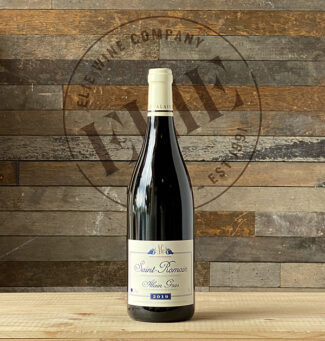 Domaine Alain Gras, 2019 Saint-Romain ($54)
Domaine Alain Gras, 2019 Saint-Romain ($54)
Pure Pinot, from vines averaging 35 years old. The bunches are 100% de-stemmed, fermented on the skins for 12 to 15 days with daily pump-overs, then aged in 15% new oak for 12 months. The wine shows black-cherry on the nose with notes of licorice and cinnamon in the background. Unpretentious wine with a bright floral finish.
Auxey-Duresses – The Best Were Sold as Volnay or Pommard
Orientation saves Auxey-Duresses from the ranks of the ordinary. Surrounded by the hills of Mont Melian, Montagne du Bourdon and Montagne du Tillet, Auxey-Duresses is stretched out along the Beaune-Autun road between Monthélie and Saint-Romain, and the hillsides face south and southeast. This geological quirk, along with the limestone content of the soil, has led to nine designated Premier Cru climats, all located on the south-facing Montagne de Bourdon hillside just behind the commune, and some excellent Village-level wines. In fact, a significant proportion Auxey-Duresses’ production is sold under the Côte de Beaune-Villages appellation, but with rising temperatures and an increasing interest in Burgundy’s backcountry wines, the value of the commune appellation is increasing year after year.
Domaine Raymond Dupont-Fahn
Raymond Dupont-Fahn is a fifth generation wine maker and began working in the family business as a child. After earning a Bac d’Oenologie diploma, he took over 12 acres of vines from his father, including plots in Meursault, Puligny-Montrachet and Auxey-Duresses. The domain is located in the village of Tailly in Meursault. As a winemaker, Raymond has cut down on the use of new oak from the 40% used by his father to just 10%, with barrels that are no older than three years. He uses no pesticides in the vineyards, aiming to be as sustainable as he can, and harvests slightly earlier than his neighbors to produce wines with better acidity and lower alcohol.
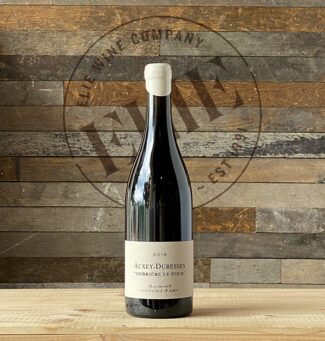 Domaine Raymond Dupont-Fahn, 2019 Auxey-Duresses ‘Derrière le Four’ ($50)
Domaine Raymond Dupont-Fahn, 2019 Auxey-Duresses ‘Derrière le Four’ ($50)
Meaning ‘behind the oven’, the wine is silky on the palate, with a fine texture entwining around a core of cherries, peonies and a hint of licorice.
Santenay – The Soul of Volnay and The Body of Pommard, No Longer Rough-hewn
Santenay is the most southerly wine-producing commune of the Côte de Beaune, and as might be expected, most of the output is red. The wines are frequently called ‘rustic’ rather than ‘elegant’ and as such, have not yet captured the imagination inherent in the poetry of Pinot Noir; Santenay is said to have the soul of Volnay and the body of Pommard. To those who love such earthy, complex Burgundies, it is well worthy of discovery.
Santenay soils contain less limestone than its northerly neighbors, and more marlstone, but proportions vary based on where the vineyard is located—grey limestone can be found up to a height of 1700 feet, while at one thousand feet, oolitic limestone lies over a layer of marl. The ideal exposure for the vineyards is east to southeast.
Domaine Bachey-Legros
Domaine Bachey-Legros attributes its vinous success to low-yielding old vines with deeply-anchored roots and concentrated juice in the grapes. “Power is matched with elegance and the voice of their terroir is loud and clear,” says Bachey-Legros owner Christiane Legros. “Balance is the key.”
The estate includes sites in Santenay, Chassagne-Montrachet, and ‘Les Maranges’ where the vines were planted between 1935 and 1955 and carefully tended by successive generations. Christiane today operates the estate with her sons Lénaïc and Samuel.
Samuel speaks further on the magic of older fruit: “Gentle extraction is de rigueur, of course, otherwise the tannins in the naturally powerful fruit is overwhelming. An old vine must be constantly monitored and maintained, nurtured and supported. Compared to a young and vigorous vine that needs keeping under control, an old vine gracefully produces berries of extraordinary concentration, imbued with the ‘goût du terroir’ which its roots have extracted from the very depths of the soil. The fruit is itself small, rich in sugars and highly concentrated.”
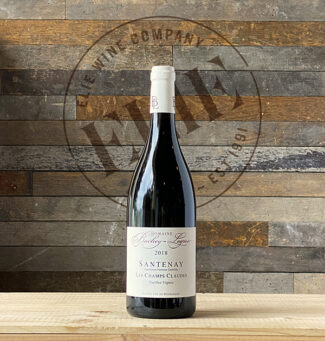 Domaine Bachey-Legros ‘Vieilles Vignes’, 2018 Santenay Les Champs Claudes ($44)
Domaine Bachey-Legros ‘Vieilles Vignes’, 2018 Santenay Les Champs Claudes ($44)
Les Champs Claudes is a fine lieu-dit located in Remigny at the northernmost end of Santenay, and according to Samuel Legros, this wine represents an archetypal Santenay. It is toasty with oak and glossy with rich cherry notes and a slight acidic crunch alongside lovely spice notes and meltingly smooth tannins.
Vintage Journal
2019 – Ripe, Concentrated, Tremendous Balance, and Very Approachable
The winter was extremely mild but moved into a chilly spring, with April seeing biting frosts that cut yields. Flowering was uneven due to a cooler than average June and some bunches suffered from millerandage, further cutting yields. Temperatures warmed up rapidly, and by July and August, many of the vines were suffering from heat and drought stress. The summer of 2019 has shown climate change at its most aggressive and much of the crop was lost due to vines either being too stressed or the grapes being sunburnt. The berries that did survive were generally richly concentrated, produced a small but excellent harvest.
2018 – Fresh with Immediate Appeal; Success in Lesser-Known Appellations
This is one of the rare vintages that offers both quality and quantity. On the face of it, 2018 was relatively straightforward; a wet winter and spring topped up the water reserves and the warm, sunny summer ensured the grapes reached ripeness without difficulty. The usual threats of disease, rot, frost and hail were minimal, and harvest took place under blue skies in 86-degree heat. However, the exceptionally warm and dry conditions posed a new challenge for vignerons, with the need to pick early enough to preserve acidity rather than the more familiar wait for ripeness to arrive. In the cellar, handling warm fruit with higher levels of sugar and lower acidity was another test for the region’s winemakers, the most diligent pulled it off beautifully.
- - -
Posted on 2022.07.25 in Côte de Beaune, Savigny-lès-Beaune, Chorey-lès-Beaune, Monthélie, Auxey-Duresses, Côte Chalonnaise, Saint-Romain, Bouzeron, Rully, Côte de Nuits, Côte de Beaune, Pernand-Vergelesses, France, Burgundy, Wine-Aid Packages
Featured Wines
- Notebook: A’Boudt Town
- Saturday Sips Wines
- Saturday Sips Review Club
- The Champagne Society
- Wine-Aid Packages
Wine Regions
Grape Varieties
Aglianico, Albarino, Albarín Blanco, Albarín Tinto, Albillo, Aleatico, Arbanne, Aubun, Barbarossa, barbera, Beaune, Biancu Gentile, bourboulenc, Cabernet Franc, Cabernet Sauvignon, Caino, Caladoc, Calvi, Carcajolu-Neru, Carignan, Chablis, Chardonnay, Chasselas, Clairette, Corvina, Cot, Counoise, Erbamat, Ferrol, Fiano, Frappato, Friulano, Fromenteau, Fumin, Garnacha, Gewurztraminer, Godello, Graciano, Grenache, Grolleau, Groppello, Juan Garcia, Lambrusco, Loureira, Macabeo, Macabou, Malvasia, Malvasia Nera, Marsanne, Marselan, Marzemino, Melon de Bourgogne, Merlot, Mondeuse, Montanaccia, Montepulciano, Morescola, Morescono, Moscatell, Muscadelle, Muscat, Natural, Nero d'Avola, Parellada, Patrimonio, Petit Meslier, Petit Verdot, Pineau d'Aunis, Pinot Auxerrois, Pinot Blanc, Pinot Gris, Pinot Meunier, Pinot Noir, Poulsard, Prieto Picudo, Rondinella, Rousanne, Roussanne, Sangiovese, Sauvignon Blanc, Savignin, Semillon, Souson, Sparkling, Sumoll, Sylvaner, Syrah, Tannat, Tempranillo, Trebbiano, Trebbiano Valtenesi, Treixadura, Trousseau, Ugni Blanc, vaccarèse, Verdicchio, Vermentino, Viognier, Viura, Xarel-loWines & Events by Date
- April 2024
- March 2024
- February 2024
- January 2024
- December 2023
- November 2023
- October 2023
- September 2023
- August 2023
- July 2023
- June 2023
- May 2023
- April 2023
- March 2023
- February 2023
- January 2023
- December 2022
- November 2022
- October 2022
- September 2022
- August 2022
- July 2022
- June 2022
- May 2022
- April 2022
- March 2022
- February 2022
- January 2022
- December 2021
- November 2021
- October 2021
- September 2021
- August 2021
- July 2021
- June 2021
- May 2021
- April 2021
- March 2021
- February 2021
- January 2021
- December 2020
- November 2020
- October 2020
- September 2020
- August 2020
- July 2020
- June 2020
- May 2020
- April 2020
- March 2020
- February 2020
- January 2020
- December 2019
- November 2019
- October 2019
- September 2019
- August 2019
- July 2019
- June 2019
- May 2019
- April 2019
- March 2019
- February 2019
- January 2019
- December 2018
- November 2018
- October 2018
- September 2018
- August 2018
- July 2018
- June 2018
- May 2018
- April 2018
- March 2018
- February 2018
- January 2018
- December 2017
- November 2017
- October 2017
- September 2017
- August 2017
- July 2017
- June 2017
- May 2017
- April 2017
- March 2017
- February 2017
- January 2017
- December 2016
- November 2016
- October 2016
- September 2016
- August 2016
- July 2016
- June 2016
- May 2016
- April 2016
- March 2016
- February 2016
- January 2016
- December 2015
- November 2015
- October 2015
- September 2015
- August 2015
- July 2015
- June 2015
- May 2015
- April 2015
- March 2015
- February 2015
- January 2015
- December 2014
- November 2014
- October 2014
- September 2014
- August 2014
- July 2014
- June 2014
- April 2014
- March 2014
- February 2014
- January 2014
- December 2013
- November 2013
- October 2013
- September 2013
- August 2013
- July 2013
- June 2013
- May 2013
- April 2013
- March 2013
- February 2013
- January 2013
- December 2012
- November 2012
- October 2012
- February 2004
Search



